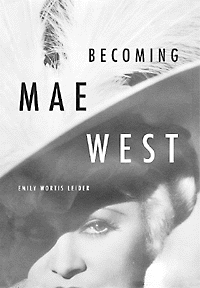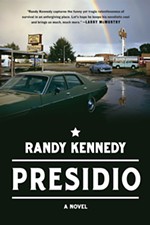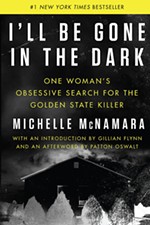Is That a Biography in Your Pocket...?
Film Folios and Screen Prints
Fri., March 13, 1998
 On page 69 of Emily Wortis Leider's biography Becoming Mae West (Farrar, Straus & Giroux, $30 hard), a vaudeville circuit manager notes in a report on a Mae West performance that "she is not volcanic in style and manifests no inclination to whoop things up. She is quiet in style and the `Nonchalant, Unique Artiste' would be more like my idea of billing her." On page 71, a New York Morning Telegraph critic decides that "Miss West can't sing a bit, but she can dance like George Cohan, and personality just permeates the air every minute she is on the stage. In other words, it isn't what Miss West does, but the way she does it that assures her a brilliant career on the stage." The apparent discrepancy is cited as an example of what Leider is up against in trying to size up as complex and iconic a persona as Mae West; it's a task the director of Madonna's Truth or Dare, Alex Keshishian, falls short of at the end of that film when he has various commentators spurt one-liners about Madonna - for some reason, almost all of them are complimentary.
On page 69 of Emily Wortis Leider's biography Becoming Mae West (Farrar, Straus & Giroux, $30 hard), a vaudeville circuit manager notes in a report on a Mae West performance that "she is not volcanic in style and manifests no inclination to whoop things up. She is quiet in style and the `Nonchalant, Unique Artiste' would be more like my idea of billing her." On page 71, a New York Morning Telegraph critic decides that "Miss West can't sing a bit, but she can dance like George Cohan, and personality just permeates the air every minute she is on the stage. In other words, it isn't what Miss West does, but the way she does it that assures her a brilliant career on the stage." The apparent discrepancy is cited as an example of what Leider is up against in trying to size up as complex and iconic a persona as Mae West; it's a task the director of Madonna's Truth or Dare, Alex Keshishian, falls short of at the end of that film when he has various commentators spurt one-liners about Madonna - for some reason, almost all of them are complimentary.
Leider is a meticulous, conscientious biographer who lends West's life the poet's touch (Leider is the author of a poetry collection and a biography of Gertrude Atherton; her next biography is of Rudolph Valentino). For example, West's younger sister Beverly isn't a mere alcoholic; in Leider's words, "booze had become Beverly's truest and most treasured companion." On West's girth: "No longer the sylph who'd shimmied with such abandon in Sometime, she'd gained sufficient avoirdupois to be dubbed `a very plump flapper' and risk unfavorable comparison to the slimmer actresses beside her on the stage.'" Leider (whose daughter is noted singer-songwriter Jean Caffeine) doubtlessly will lend the same care and poetry to Rudolph Valentino, her next biographical subject whom she was recently researching at UT's Harry Ransom Humanities Research Center. The dead Valentino materializes in Becoming Mae West as one of West's few reflective outlets. She reportedly attempted to reach him twice in seances because she realized "their kinship - the hyperbolic sexuality, theatricality, cult status, and glamour they shared."
That West's hyperbolic sexuality was not just a cinematic put-on is one of the surprises in the biography. It's hard to deny that experience counts for everything, but somehow West's vampy, glamour-mediated onscreen persona comes across as just an act of the imagination. It's such a vampy put-on, in fact, that it seems the things she says and does in her films couldn't possibly have been the result of actual experiences. Not so, as this sentence, among others, evinces: "Mae rang in her banner New York year, 1928, with a one-night stand, hosting a nightclub, a la Texas Guinan, at Park Avenue and Fifty-ninth Street's Club Deauville."
Becoming Mae West ends after the release of 1938's Every Day's a Holiday, which failed to beat out Disney's first animated feature, Snow White and the Seven Dwarfs, "which Mae said would have made even more money if she'd played Snow White. `I used to be Snow White,' she'd quip, `but I drifted.'" Leider's decision to end the biography at that moment allows her to discuss West in iconic terms but not to neglect the often gritty existence West led before she staked her existence on glamour. If she thought about it at all, West would have agreed with something Leider said when she was in town recently: "Canonization is for people who weren't there at the time." - Claiborne Smith
Willie Morris, the South's leading man of letters, doesn't disappoint in his latest book, a Mississippi moviemaking missive called The Ghosts of Medgar Evers (Random House, $23 hard). There isn't much Morris hasn't encountered in his years as a journalist and writer (he was editor of The Daily Texan and Texas Observer as well as Harper's), but the film industry is new territory for him.
Given this remote vantage point, what's surprising is that he treats the people and process with kid gloves. Granted, it's hard to be ambivalent when Hollywood comes to town and especially when the subject matter is as sensitive as Rob Reiner's film The Ghosts of Mississippi. The 1997 motion picture, starring Alec Baldwin and James Woods, portrays the 1963 murder of civil rights activist Medgar Evers and the conviction of his murderer Byron De La Beckwith 30 years later. Race, murder, and Hollywood make an interesting story and Morris' book, as an essay on the contemporary South and studio films, is flawless. The Ghosts of Medgar Evers is a worthy successor to his other nonfiction works, including the classic autobiographies North Toward Home and New York Days and is as fine an evocation of his native state as two of his other books, The Courting of Marcus Dupree and Faulkner's Mississippi. When it comes to Mississippi and the movies, Morris writes, "There may be no two more disparate places in America than Hollywood and Mississippi, which exist so distantly in the Great Republic as to be nearly untranslatable to each other. Yet there had always been a Mississippi connection in Hollywood, which had intrigued me, primarily in its embodiment in the unique and unlikely duo of William Faulkner and Elvis Presley, each of whom spent considerable time in the motion picture calling."
If The Ghosts of Mississippi had sprung from the one-track mind of John Grisham and not been the factual retelling of the extraordinary events leading to the conviction of Byron De La Beckwith 30 years after he murdered civil rights leader Medgar Evers, it might have made $100 million. Ghosts made well below one-quarter of that blockbuster highwater mark. While Ghosts was scouting locations in Mississippi, two other Grisham films were underway, The Chamber and A Time to Kill, which would catapult Austin's own Ken doll, Matthew McConaughey, to stardom.
The lack of commercial success may be Castle Rock and Rob Reiner's way of paying for their altruistic sins. Of course, predicting box office returns is like anticipating where lightning will strike - an inexact science at best. Director Rob Reiner highlights the essential "entertainment or important film" conflict saying, "Most people get their history through movies, you know." As Jami Bernard wrote in a New York Daily News review of the film, "Making history palatable for a movie audience is no easy task. Fact and fiction collide with their separate agendas." Adding to the marketing dilemmas were predictable attacks by liberals who criticized Reiner for involving himself in a "white man's" motion picture about the race issue - that its focus was on white people in what was a black struggle for justice." Alec Baldwin told Morris that "some prominent black figures in our society either withheld their support or bashed us outright, as Spike Lee did," whose raison d'etre is racial disharmony. Conservative whites of the Byron De La Beckwith bent didn't much care for the movie, either.
Morris opens the book with a memorable visit to the film set at the Windsor Ruins, an antebellum Stonehenge located near Port Gibson, Mississippi. The production designer, Lilly Kilvert, asked Morris for a "specific site that would establish the texture and feel of Mississippi early on in the movie, some place that audiences would not easily forget." Kilvert got what she wanted - "a haunting location" - and readers get what they wanted, a film and book that will endure.
- Cary L. Roberts
SCTV: Behind the Scenes (McClelland & Stewart, $17.95 paper) by Dave Thomas is the alumnus' inside chronicle of what was arguably the most innovative and consistently funny sketch comedy program ever.
The book is a fan's dream, loaded with interviews and anecdotes about the show that preferred to exist in Saturday Night Live's shadow. Juxtaposed, SCTV always seemed like a bootleg version; originating from Canada, it aired after SNL in most markets, its sets and production qualities seemingly bargain-basement by comparison. And even its cast seemed anonymous, set against the heavyweights over at SNL - several of whom launched their careers at Second City.
SCTV was shot in Edmonton, where cast and crew were isolated from big-city distraction. According to Dave Thomas, it was this forced togetherness that brought out the best in everyone. Thomas writes that SCTV benefited by never having huge budgets - a challenge that not only shaped the show's concept (a day in the life of a small TV operation), but kept cast members on equal footing.
Compared with Saturday Night Live, SCTV might have seemed like nothing more than the improvised prattle of Bob and Doug MacKenzie, the quintessential Canucks who eventually brought the show wide recognition. But actually, the show always maintained a huge creative advantage. While SNL was frenzied - knocking out topical, live humor each week - SCTV worked ahead. Thus, SCTV's material was often more original, and less news-oriented (and has held up better in reruns).
Back in the mid-1970s, the Second City stage company (including John Belushi, Gilda Radner and Dan Aykroyd) evolved from a Chicago-only operation to include a Toronto troupe. The Canada group spawned the talent-rich nucleus of SCTV: Harold Ramis, John Candy, Rick Moranis, Martin Short, Joe Flaherty, Catherine O'Hara, Eugene Levy, Andrea Martin, and Thomas.
At the height of SCTV (around 1981-82), the cast and comedy positively sparkled. The troupe's dead-on impersonations had improved and the writing had become razor-sharp and even multi-layered - so that a sketch featuring Rick Moranis as Merv Griffin would suddenly be interrupted by Dave Thomas' impersonation of Steven Spielberg, transforming the skit to Merv: The Special Edition - combining parodies of The Merv Griffin Show, 2001 and a special video release of Spielberg's film, Close Encounters: The Special Edition.
The book includes trivia for hardcore fans and closes with fond remembrances of the late John Candy. Lengthier documentation of specific skits would have made this hands-down the definitive SCTV book - plus, Thomas is overly apologetic for Bob and Doug MacKenzie. The ale-swilling dunderheads, he says, achieved undeserved prominence that became a source of cast friction. But hey, the MacKenzie Brothers were funny - and besides, Thomas must not be too embarrassed; in 1997, he and Moranis were busy reprising their Take Off! roles for Molson TV commercials. - Stuart Wade
Monster: Living off the Big Screen by John Gregory Dunne (Random House, $12 paper) is the latest in a fascinating line of books purporting to be insider accounts of what happens during the making of Hollywood movies. Monster's notable predecessors, Lilian Ross' 1952 Picture, a reporter's perspective of the making of John Huston's The Red Badge of Courage and Steven Bach's Final Cut, a studio executive's version of the true monster that ended up to be Heaven's Gate, share much with this book, Dunne's account of his and his wife Joan Didion's eight-year-long role in writing the screenplay for what would eventually became the 1996 film Up Close & Personal.
"Eventually" is the operative word here, since their screenplay started out as a biopic about Jessica Savitch, the broadcast journalist whose rise to the top occasioned a tragic vocational and personal descent that ended with her death in 1983. Like Tally Atwater, the relatively saccharine Up Close & Personal character played by Michelle Pfeiffer, Jessica Savitch had a Svengalian relationship with a producer who, according to Dunne, flirted with drugs, ambivalent sexuality, and was generally ambivalent about most everything. Monster does illuminate the constrictive processes that occur in mainstreaming a potentially "dangerous" topic; according to Dunne, a Disney executive wanted to construct out of the screenwriters' cautionary and revealing tale a message that would leave the audience "happy." The only problem - and it is an appreciable one - is that Savitch's life was hardly the sort that is conducive to producing "happy" audiences.
This is the problem that plagues not only the screenwriters but Dunne's telling of his Hollywood story. He easily elicits sympathy from the reader for his financial dependence (especially during his recent, serious illnesses) on a process that takes his valuable material, chews it up, and spits it out as something else entirely. But Dunne attempts to have his cake and eat it too, producing the weird, contradictory politics that are at work in Monster. Dunne maligns various producers (about whom he writes, "What producers do is rarely understood, and seldom appreciated," one of the clearest assessments yet on producers' doings). In addition, he maligns various malfeasants who seem to exist only to mediocritize the couple's screenplay. For example, Dunne excerpts a snippet of one of Up Close & Personal's producers Scott Rudin, who actually ends up as a "good guy" in Monster. Dunne: "Scott, what do you think this picture is really about?" Rudin: "It's about two movie stars." A least we hear the truth, and in this, Dunne performs a legitimate criticism of the Hollywood system.
But Dunne also expects us to understand why he continues to work in a system he quite clearly would prefer not to touch with a 10-foot pole. Perhaps love and hate conjoined are inevitable when dealing with Hollywood, but if so, Dunne lets the hate get to him in a manner that conveys his inability to really conquer the petty squabbles various characters in Monster create to ensnare Dunne and Didion's eventual success with their screenplay. Monster thus becomes a long, public excuse for Dunne and Didion's routine screenplay, not to mention an excuse to dish the Hollywood creatures who slime their way across the writers' paths.
Read Monster and learn useful Hollywood lingo when dealing with screenplays: "OTN" for "on the nose," OTT for "over the top," and "OH" for "old hat." Just don't expect a particularly clear-cut account of two writers' descent into development hell. - Claiborne Smith








